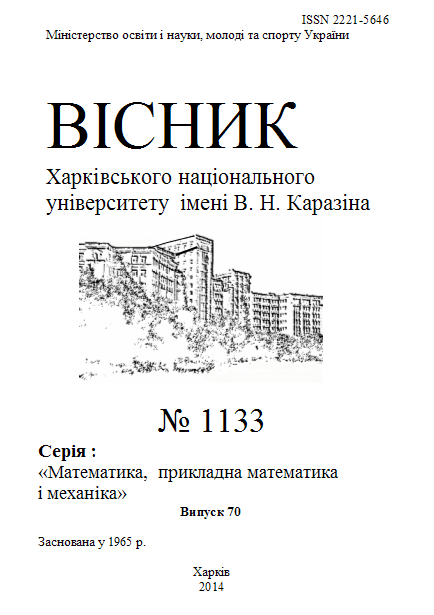Кілька підходів до визначення меж зміни збурення в задачі глобального робастного синтезу
Анотація
Розглянуто задачу глобальногоробастного позиційного синтезу обмеженого керування системою з невідомими обмеженими збуреннями. На основі методу функції керованості В.І. Коробова запропоновано різноманітні підходи до знаходження меж зміни збурення. Побудоване незалежне від збурення керування, яке переводить довільну початкову точку у початок координат заскінчений час, для якого наведена оцінка зверху.
Завантаження
Посилання
Коробов В. И. Общий подход к решению задачи синтеза ограниченных управлений в задаче управляемости / Математический сборник, 1979. – Т. 109 (151), № 4 (8). – C. 582-606.
Коробов В. И. Решение задачи синтеза с помощью функции управляемости / Доклады АН СССР, 1979. – Т. 248, № 5. – C. 1051-1055.
Коробов В. И. Решение задачи синтеза для управляемых процессов с возмущениями с помощью функции управляемости / Дифференц. уравн., 1987. – Т. 23, № 2. – С. 236-243.
Коробов В. И. Метод функции управляемости. / М.-Ижевск: НИЦ "Регулярная и хаотическая динамика", 2007. – 576 с.
Коробов В. И., Гавриляко В. М. Робастные системы. Синтез ограниченного управления / Вісник Харківського національного університету імені В. Н. Каразіна. Серія "Математика, прикладна математика і механіка'', 2005. – № 711. – С. 23-27.
Коробов В. И., Скляр Г. М. Методы построения позиционных управлений и допустимый принцип максимума / Дифференциальные уравнения, 1990. – Т. 26, № 11. – C. 1914-1924.
Поляк Б. Т., Щербаков П. С. Робастная устойчивость и управление. / М.: Наука, 2002. – 303 с.
Ревина Т. В. Решение одной задачи синтеза управления для робастных систем на основе метода функции управляемости / Динамические системы. Таврический нац. ун-т им. В. И. Вернадского. – Симферополь, 2008. – Вып. 25. – с. 83-93.
Скорик В. А. Аналитическое обращение одного семейства плохо обусловленных матриц, возникающих в методе функции управляемости / Вісник Харківського національного університету імені В.Н. Каразіна. Серія "Математика, прикладна математика і механіка'', 1999. – № 444. – С. 15-23.
Хорн Р. А., Джонсон Ч. Р. Матричный анализ./ Изд-во "Наука". Гл. ред. физ.-мат. лит., М, 1989. – 656 с.
Bowong S., Moukam Kakmeni F. M. Chaos control and duration time of a class of uncertain chaotic systems / Physics Letters, 2003. – A 316. – P. 206-217.
Bhat S. P., Bernstein D. S. Finite-time stability of continious autonomous systems / SIAM Journal of Control and Optimization, 2000. – Vol. 38. – No. 3. – P. 751-766.
Ding S., Qian C., Li S. Global finite-time stabilization of a class of upper-triangular systems / Proceeding of the 2010 American Control Conference, Baltimore, MD, USA, 2010, June 30 – July 2. – P. 4223-4228.
Franze G., Carotenuto L., Muraca P. On the stability of interval matrices / Proceeding of the 2004 American Control Conference, Boston, Massachusets, USA, 2004, June 30 – July 2. – P. 2648-2653.
Hong Y. Finite-time stabilization of nonlinear systems with parametric and dynamic uncertainties / IEEE Trans. On Automatic Control, 2006. -– Vol. 51. – No. 12. – P. 1950-1956.
Juang Y. T., Shao C. S. Stability analysis of dinamic interval systems / Int. J. Сontr., 1989. – Vol. 49. – P. 1401-1408.
Polyakov A, Efimov D, Perruquetti W. Finite-time stabilization using implicit Lyapunov function technique / IFAC Nolcos, hal-00844386, version 1-15, Jul 2013.
Rodoumta K., Bowong S. Construction of bounded feedback by the controllability function method// Applied mathematical sciences, 2007. – Vol. 1. – No 6. – P. 267-279.
Rohn J. Positive definitess and stability of interval matrices / SIAM J. Matrix anal. appl., 1994. – Vol. 15. – No. 1. – P. 175-184.
Wang K, Michel A, Liu D. Nessesary and sufficient conditions for the Hurwitz and Schur stability of interval matrices / IEEE Trans. on Automatic Control, 1994. – Vol. 39. – No. 6. – P. 1251-1255.
Автори, які публікуються у цьому журналі, погоджуються з наступними умовами:
1. Автори залишають за собою право на авторство своєї роботи та передають журналу право першої публікації цієї роботи на умовах ліцензії Creative Commons Attribution License, котра дозволяє іншим особам вільно розповсюджувати опубліковану роботу з обов'язковим посиланням на авторів оригінальної роботи та першу публікацію роботи у цьому журналі. (Attribution-Noncommercial-No Derivative Works licence).
2. Автори мають право укладати самостійні додаткові угоди щодо неексклюзивного розповсюдження роботи у тому вигляді, в якому вона була опублікована цим журналом (наприклад, розміщувати роботу в електронному сховищі установи або публікувати у складі монографії), за умови збереження посилання на першу публікацію роботи у цьому журналі.
3. Політика журналу дозволяє і заохочує розміщення авторами в мережі Інтернет (наприклад, у сховищах установ або на особистих веб-сайтах) рукопису роботи, як до подання цього рукопису до редакції, так і під час його редакційного опрацювання, оскільки це сприяє виникненню продуктивної наукової дискусії та позитивно позначається на оперативності та динаміці цитування опублікованої роботи (див. The Effect of Open Access).




